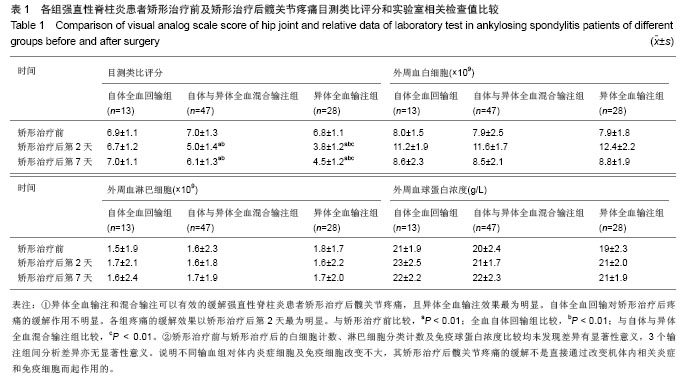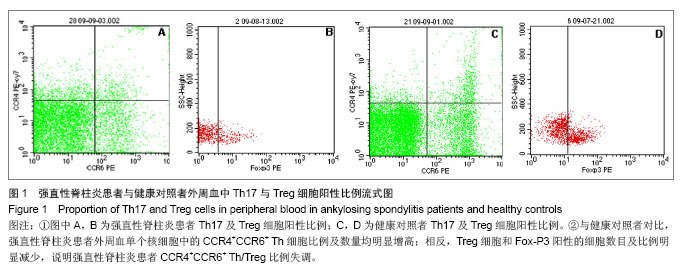| [1]Feldtkeller E, Khan MA, van der Heijde D,et al. Age at disease onset and diagnosis delay in HLA-B27 negative vs. positive patients with ankylosing spondylitis.Rheumatol Int. 2003; 23(2):61-66.[2]Zvyagin IV, Mamedov IZ, Britanova OV,et al. Contribution of functional KIR3DL1 to ankylosing spondylitis.Cell Mol Immunol. 2010;7(6):471-476.[3]Braun J, Sieper J.Ankylosing spondylitis.Lancet. 2007; 369 (9570):1379-1390.[4]白人骁,毕晓阳,张福江,等.关节成形术治疗强直性脊柱炎晚期严重髋关节畸形[J].中华骨科杂志,1999,19(7):400-403. [5]高志国,于建华,徐世玺,等.强直性脊柱炎全髋关节置换术的常见问题及其处理[J].中华骨科杂志,2000,20(12):728-731.[6]Shen H, Goodall JC, Hill Gaston JS. Frequency and phenotype of peripheral blood Th17 cells in ankylosing spondylitis and rheumatoid arthritis. Arthritis Rheum. 2009;60(6):1647-1656.[7]van der Linden S, Valkenburg HA, Cats A. Evaluation of diagnostic criteria for ankylosing spondylitis. A proposal for modification of the New York criteria. Arthritis Rheum. 1984; 27(4):361-368.[8]Benedek TG.How did ankylosing spondylitis become a separate disease. Clin Exp Rheumatol. 2009;27(4 Suppl 55): S3-9.[9]Brewerton DA, Hart FD, Nicholls A,et al. Ankylosing spondylitis and HL-A 27.Lancet. 1973;1(7809):904-907.[10]Mei Y, Pan F, Gao J, et al. Increased serum IL-17 and IL-23 in the patient with ankylosing spondylitis.Clin Rheumatol. 2011;30(2):269-273. [11]Harrington LE, Hatton RD, Mangan PR,et al. Interleukin 17-producing CD4+ effector T cells develop via a lineage distinct from the T helper type 1 and 2 lineages.Nat Immunol. 2005;6(11):1123-1132.[12]Park H, Li Z, Yang XO,et al. A distinct lineage of CD4 T cells regulates tissue inflammation by producing interleukin 17.Nat Immunol. 2005;6(11):1133-1141. [13]Ghoreschi K, Laurence A, Yang XP,et al.T helper 17 cell heterogeneity and pathogenicity in autoimmune disease.Trends Immunol. 2011;32(9):395-401. [14]Aggarwal S, Pittenger MF. Human mesenchymal stem cells modulate allogeneic immune cell responses.Blood. 2005; 105(4):1815-1822. [15]Takahashi T, Sakaguchi S.The role of regulatory T cells in controlling immunologic self-tolerance.Int Rev Cytol. 2003; 225:1-32.[16]Sakaguchi S, Ono M, Setoguchi R,et al. Foxp3+ CD25+ CD4+ natural regulatory T cells in dominant self-tolerance and autoimmune disease.Immunol Rev. 2006;212:8-27.[17]Wang X, Lin Z, Wei Q,et al. Expression of IL-23 and IL-17 and effect of IL-23 on IL-17 production in ankylosing spondylitis.Rheumatol Int. 2009;29(11):1343-1347. [18]Iwakura Y, Ishigame H.The IL-23/IL-17 axis in inflammation.J Clin Invest. 2006;116(5):1218-1222.[19]Boissier MC, Assier E, Falgarone G,et al. Shifting the imbalance from Th1/Th2 to Th17/treg: the changing rheumatoid arthritis paradigm.Joint Bone Spine. 2008; 75(4):373-375. [20]Ehrenstein MR, Evans JG, Singh A,et al. Compromised function of regulatory T cells in rheumatoid arthritis and reversal by anti-TNFalpha therapy.J Exp Med. 2004;200 (3): 277-285. [21]Bettelli E, Carrier Y, Gao W,et al. Reciprocal developmental pathways for the generation of pathogenic effector TH17 and regulatory T cells.Nature. 2006;441(7090):235-238.[22]Langrish CL, Chen Y, Blumenschein WM,et al. IL-23 drives a pathogenic T cell population that induces autoimmune inflammation.J Exp Med. 2005;201(2):233-240.[23]Murphy CA, Langrish CL, Chen Y,et al. Divergent pro- and antiinflammatory roles for IL-23 and IL-12 in joint autoimmune inflammation.J Exp Med. 2003;198(12):1951-1957.[24]Taylan A, Sari I, Kozaci DL,et al. Evaluation of the T helper 17 axis in ankylosing spondylitis. Rheumatol Int. 2012;32(8): 2511-2515. [25]Van bezooijen RL, Farih-Sips HC, Papapoulos SE,et al. Interleukin-17: A new bone acting cytokine in vitro.J Bone Miner Res. 1999;14(9):1513-1521.[26]Chabaud M, Miossec P.The combination of tumor necrosis factor alpha blockade with interleukin-1 and interleukin-17 blockade is more effective for controlling synovial inflammation and bone resorption in an ex vivo model.Arthritis Rheum. 2001;44(6):1293-1303.[27]Huang W, Schwarz EM.Mechanisms of bone resorption and new bone formation in spondyloarthropathies.Curr Rheumatol Rep. 2002;4(6):513-517.[28]Rifas L, Arackal S.T cells regulate the expression of matrix metalloproteinase in human osteoblasts via a dual mitogen-activated protein kinase mechanism.Arthritis Rheum. 2003;48(4):993-1001.[29]Poole AR.The histopathology of ankylosing spondylitis: are there unifying hypotheses. Am J Med Sci. 1998;316(4):228- 233.[30]Bárdos T, Szabó Z, Czipri M,et al. A longitudinal study on an autoimmune murine model of ankylosing spondylitis.Ann Rheum Dis. 2005;64(7):981-987.[31]Kimura A, Kishimoto T. IL-6: regulator of Treg/Th17 balabce. Eur J Immunol. 2010;40(7):1830-1835.[32]Nistala K, Wedderburn LR.Th17 and regulatory T cells: rebalancing pro- and anti-inflammatory forces in autoimmune arthritis. Rheumatology (Oxford). 2009;48(6):602-606.[33]Zhou L, Lopes JE, Chong MM,et al.TGF-beta-induced Foxp3 inhibits T(H)17 cell differentiation by antagonizing RORgammat function.Nature. 2008;453(7192):236-240.[34]Miceli-Richard C, Dougados M.NSAIDs in ankylosing spondylitis.Clin Exp Rheumatol. 2002;20(6 Suppl 28):S65-66.[35]Barr A, Keat A.Spondyloarthritides: evolving therapies.Arthritis Res Ther. 2010;12(6):221. [36]Gorman JD, Sack KE, Davis JC Jr.Treatment of ankylosing spondylitis by inhibition of tumor necrosis factor alpha.N Engl J Med. 2002;346(18):1349-1356. [37]Shaikh SA.Ankylosing spondylitis: recent breakthroughs in diagnosis and treatment.J Can Chiropr Assoc. 2007;51(4): 249-260.[38]Fouque-Aubert A, Jette-Paulin L, Combescure C,et al. Serious infections in patients with ankylosing spondylitis with and without TNF blockers: a systematic review and meta-analysis of randomised placebo-controlled trials. Ann Rheum Dis. 2010;69(10):1756-1761.[39]Miller EA, Ernst JD.Anti-TNF immunotherapy and tuberculosis reactivation: another mechanism revealed.J Clin Invest. 2009;119(5):1079-1082.[40]Nacci F, Matucci-Cerinic M.Tuberculosis and other infections in the anti-tumour necrosis factor-alpha (anti-TNF-α) era.Best Pract Res Clin Rheumatol. 2011;25(3):375-388. |



.jpg)